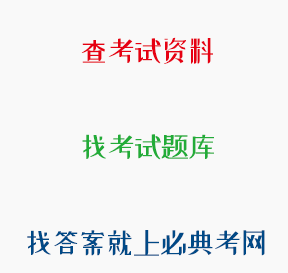正确答案: A
劳动起源说
题目:马克思主义教育学在教育起源问题上坚持( )。
解析:劳动起源论是指劳动创造了人类和社会,劳动过程的复杂性要求通过教育把人类积累的经验传授给下一代,人类原始时代教育活动已经存在了,教育是一种永恒的社会现象。劳动,是人类社会形成的基础,劳动也是人类最原始的现象。故选择A。B项,教育生物起源论者认为,人类教育发源于动物界中各类动物的生存本能活动。主张生物起源的代表人物有利托尔诺、沛西·能等。C项,心理起源论的主要代表人物是美国教育家孟禄,心理起源论者认为教育起源于儿童对成人无意识的模仿。D项,达尔文进化论是19世纪中叶,达尔文创立了科学的生物进化学说,以自然选择为核心,第一次对整个生物界的发生、发展,作出了唯物的、规律性的解释,推翻了神创论等唯心主义及形而上学在生物学中的统治地位,使生物学发生了一个革命变革。
查看原题 查看所有试题
学习资料的答案和解析:
[单选题]情境:刚刚范读完课文,我却发现坐在后排的一个女同学在偷偷地写什么东西。我不动声色走过去,原来是一张小纸条!我把它没收了。展开一看,只见上面赫然写着班上一个男生的名字,还有几句稚气的话……班里几个调皮的男生,大声地喊:"老师念出来!"为了保护女同学的自尊心,我洋装念道:"上面写着:听毛主席的话,做一个好学生!"瞬间,班里一片笑语。对于该老师的做法,下面选项中认识不正确的一项是()。
该老师应该无视调皮男生的要求,维护课堂纪律
解析:对于材料中出现的情况,老师最好的处理办法应该是因利势导,巧妙地化解课堂中发生的意外情况,而不是视而不见。故选C选项。
[单选题]某单位有五名业务骨干小张、小王、小赵、小丁、小李参加了一次技能测验,他们的测验成绩呈现为:小赵没有小李高,小张没有小王高,小丁不比小李低,而小王不如小赵高。请问,小张、小王、小赵、小丁、小李测验成绩谁最高( )。
小丁
解析:由题干信息可知,小李>小赵,小赵>小王>小张,小丁≥小李,即小丁≥小李>小赵>小王>小张。故选择A项。
[单选题]教育即生长"反映的教育目的论是( )。
教育无目的论
解析:杜威在《民主主义与教育》中指出教育的过程,在它自身以外没有目的,它就是它自己的目的。"杜威所否定的是教育的一般的、抽象的目的,强调的是教育过程内有的目的,即每一次教育活动的具体目的,并非主张教育完全无目的。教育即生长"就是杜威对于教育本质的论述。故选择C。A项,神学目的论即宗教本位论,西欧中世纪盛行,代表人物:奥古斯丁、托马斯·阿奎那等。B项,社会本位教育目的论的观点是:从社会发展需要出发,注重教育的社会价值;主张教育的目的是培养合格公民和社会成员;教育是国家的事业;评价教育要看其对社会的发展贡献的指标。D项,个人本位教育目的论的观点是:从个体本能需要出发,强调教育要服从人的成长规律和满足人的需要;注重教育对个人的价值;主张教育的目的是培养"自然人",发展人的个性,增进人的价值,促使个人自我实现。
[单选题]某校大力美化了校园环境,注重校园文化建设,确定了校风校训、班风班训等。这种现象说明该校重视( )。
隐性课程
解析:隐性课程是学校情境中以间接的、内隐的方式呈现的课程,如师生关系、校风、学风等。
[单选题]科尔伯格研究儿童的道德认知所采用的方法是( )。
两难故事法
解析:科尔伯格研究儿童的道德认知所采用的方法是两难故事法,让被试者在两难推论中作出是非、善恶的判断并说明理由。这一系列两难推理故事中,最著名、最典型的是"海因兹偷药"的故事。
[单选题]Passage 2
The subject of ballads, books and films,Robin Hood has proven to be one of popular
culture's most enduring folk heroes. Overthe course of 700 years, the outlaw fromNottingham shire who robs the rich to giveto the poor has emerged as one of the most enduring folk heroes in popular culture andone of the most versatile. But how has thelegend of Sherwood Forests merry out laws evolved over time? Did a real Robin Hood inspire these classic tales?
Beginning in the 15th century and perhaps even earlier, Christian revelers in certain partsof England celebrated May Day with plays and games involving a Robin Hood figure withnear-religious significance. In the 19th century,writer-illustrators like Howard Pyle adaptedthe traditional tales for children, popularizingthem in the United States and around theworld.More recently, bringing Robin to thesilver screen has become a rite of passagefor directors ranging from Michael Curtiz andRidley Scott to Terry Gilliam and Mel Brooks.
Throughout Robins existence, writers,performers and filmmakers have probed theirimaginations for new incarnations thatresonate with their respective audiences.In 14th-century England, where agrarian discontent had begun to chip away atthe feudal system, he appears as an anti-establishment rebel who murders government agents and wealthy landowners. Latervariations from times of less social upheaval dispense with the gore and cast Robin as a dispossessed aristocrat with a heart of gold and a love interest, Maid Marian.
Academics. meanwhile have combedthe historical record for evidence of a realrobin Hood English legal records suggestthat, as early as the 13th century, “Robehod,”“Rabunhod”and other variations had become common epithets for criminals. But what hadinspired these nicknames: a fictional tale,an infamous bandit or an amalgam of both?The first literary references to Robin Hood appear in a series of 14th- and 15th-century ballads about a violent yeoman who lived inSherwood Forest with his men and frequently clashed with the Sheriff of Nottingham.Rather than a peasant, knight or fallennoble, as in later versions, the protagonistof these medieval stories is a commonerLittle John and Will Scarlet are part of thisRobin's “merry”crew--meaning, at the time, anoutlaws gang--but Maid Marian, Friar Tuck and Alan-a-Dale would not enter the legend untillater, possibly as part of the May Day rituals.
While most contemporary scholarshave failed to turn up solid clues, medieval
chroniclers took or granted that a historicalRobin Hood lived and breathed during the 12thor 13th century. The details of their accountsvary widely, however, placing him in conflictingregions and eras. Not until John Majors“History of Greater Britain”(1521), for example,is he depicted as a follower of King Richard,one of his defining characteristics in moderntimes.
We may never know for sure whetherRobin Hood ever existed outside the versesof ballads and pages of books. And even ifwe did, fans, young and old, would still surelyflock to England's Nottinghamshire region for a tour of the legends alleged former hangouts,from centuries-old pubs to the Major Oak inSherwood Forest.What we do know is thatthe notion of a brave rebel who live on theoutskirts of society, fighting injustice andoppression with his band of companions, hauniversal appeal-whether he's played by ErrollFlynn, Russell Crowe or even, as on a 1979 episode of“The Muppet Show, Kermit the Frog.”
Which of the following is closest in meaningto the underlined phrase“a rite of passage”in Paragraph 2?
A milestone event
解析:根据画线词定位到文章第二段。该段主要讲述了在不同时期,Robin hood的形象从充满宗教色彩,到融人儿童故事,再到被搬上大荧幕的经历变化。A rite of passage所在句子意为“将Robin的形象搬到荧幕上对各位导演来说,已经成为。A项“一件具有里程碑意义的事”,B项“一项头等议程”,C项“一个宗教仪式”,D项“一项特权”。A项最符合原文意思。故选择A。
[单选题]
and...north of Sante Fe.”可知Fenn想让人们寻宝,可见他应该是在盒子中装满了珠宝首饰,故可推知fill更合适,fill(sth.) with(sth.)“使充满,装满,注满,填满”。故选择A。
Why did Fenn design a treasure hunt afterhe was diagnosed with cancer?
He wanted to help himself andgame-and telly-addicted kids.
解析:句意为“为什么Fenn在被诊断为癌症之后设计了一个寻宝计划?”。A项,意为“他喜欢冒险,情不自禁地去做这件事”;B项,意为“他想帮助自己,帮助那些沉迷于游戏和电视的孩子”;C项,意为“他想让孩子们离开游戏室和他一起玩”;D项,意为“他认为这会给他带来希望、兴奋和长寿”。根据diagnosed with cancer可定位到文章第三段,可知,Fenn设计寻宝活动是为了在自己临死之前寻找创造一些刺激和希望,并且希望孩子们离开游戏室,多进行户外活动。
[单选题]像任何事物的发展一样,学生晶德的发展也是由其内部矛盾推动的。学生品德发展的内部矛盾是( )。
学生品德发展的新需要与其现有发展水平之间的矛盾
解析:德育过程是促使学生思想内部矛盾运动的过程。学生思想品德发展的内部矛盾表现为当前德育要求产生的思想品德发展新需要与受教育者已有思想品德水平之间的矛盾。
[单选题]When implementing the project,we________a lot of unexpected opposition from our
colleagues.
run up against
解析:本题考查动词短语辨析。run for“竞选”,make against“不利于”,run up against“遇到,遭遇”,make away with“携......而逃,除去,杀死”。句意为“当实施计划时,我们遭到来自同事们的意料不到的反对”。故本题选C。

 川公网安备 51012202001360号
川公网安备 51012202001360号